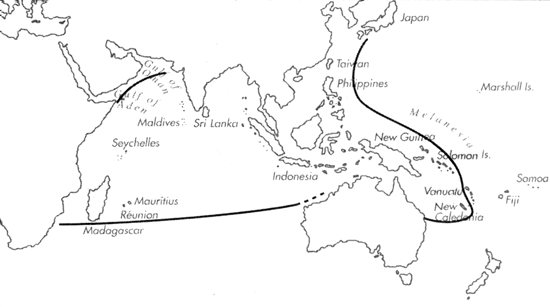
Skip Navigation Links
View access keys for this site.

Range: South Africa to Oman and to the Ryukyu Is., New Caledonia, Solomon Is. and Queensland; absent from the Red Sea.
Description: Moderately large to large, solid to heavy. Last whorl ventricosely conical to broadly and ventricosely conical, less frequently conical, broadly conical or approaching pyriform; outline usually straight at abapical two-thirds and convex to strongly convex above, sometimes slightly concave near base. Shoulder subangulate to rounded. Spire of low to moderate height, outline variably concave. Teleoconch sutural ramps flat to slightly convex, with numerous spiral striae. Basal third of last whorl with variably broad spiral ribs.
| Shell Morphometry | ||
|---|---|---|
| L | 55-177 mm | |
| RW | 0.50-4.60 g/mm | |
| (L 55-165 mm) | ||
| RD | 0.63-0.81 | |
| PMD | 0.77-0.87 | |
| RSH | 0.03-0.14 | |
Ground colour yellowish tan to orangish brown, less often cream white mottled with yellow or orange; occasionally, ground overlaid with grey. Last whorl generally with spiral rows of brown markings, varying from a great number of closely set rows to absence of rows. Markings vary from narrow spiral dashes to rectangular bars and from dots to round or squarish spots and axial flecks. Dark markings alternate regularly with white markings that are often absent from adapical two-thirds. Basal part of last whorl may be of darker colour. Early teleoconch sutural ramps immaculate; later ramps variously maculated with dark brown spots or radial streaks and blotches. Aperture white, sometimes pale yellow or violet; smaller shells often suffused with violet-brown deep within.
Periostracum brown, thin to thick, translucent to almost opaque, with fine to strong and interlaced axial ridges.
Foot yellowish tan, axially streaked with violet. Rostrum violet. Siphon pale yellow at base, blackish brown distally (Quoy & Gaimard, 1835).
Radular teeth with an adapical barb opposite a large weakly pointed second barb; serration consists of a double row of strong denticles, extends as far as the blade or halfway down the shaft and ends in a cusp; shaft with a slight constriction at centre, base with a pronounced spur (Bergh, 1895; Peile, 1939; Kohn, unpubl. observ.).
Habitat and Habits: Intertidal to about 50 m; in sheltered bays and on reefs, inhabiting sand pockets, sand flats and muddy sand. Typical form lives mostly above 20 m; form zulu is reported from 30-50 m (Petuch, 1979). C. betulinus probably feeds on worms (Kohn, 1978).
Discussion: C. betulinus is similar to C. suratensis, C. figulinus, C. loroisii, and C. glaucus. C. suratensis is often difficult to distinguish from C. betulinus. It does not attain as large size as the latter species, generally has a narrower last whorl (RD 0.59-0.69) as well as a lower spire (RSH 0.02-0.06); the spiral sculpture of its last whorl consists of ribbons, and its pattern has more but smaller brown markings that are also axially aligned. For comparison with C. figulinus, C. loroisii, and C. glaucus, see the DISCUSSIONS of these species. We assign specimens from the E. African coast between Natal and Mozambique described as C. zulu (Pl. 13, Figs. 9-11) to C. betulinus, although they may represent hybrids between C. betulinus and C. figulinus. At these localities and Madagascar and India, C. figulinus (L 45-90 mm), typical C. betulinus (L 75-175 mm) and moderately large adults (L 55-80 mm) appearing intermediate in shape and colour pattern co-occur in the same habitat. Should the latter shells be assigned to C. betulinus or be regarded as hybrids? Their last whorl, which may be slightly pyriform, often has a mixed grey, greenish and brownish ground colour with a contrasting shoulder band and variably fine dashed and dotted spiral lines; their spire may be relatively higher (0.05-0.14 vs. 0.03-0.10 in more typical C. betulinus). The morphometry of their last whorl (RD 0.66-0.78; PMD 0.82-0.86), the pronounced intermittent white dashes of their abapical spiral rows and the axial blotches of their sutural ramps suggest that they are assignable to C. betulinus rather than representing true intermediates with C. figulinus (RD 0.52-0.74; PMD 0.74-0.84). The shells from Natal and Mozambique described as C. zulu differ from the shells from Madagascar in a less conical last whorl, a mostly steeper shoulder ramp and a consistently fine pattern. Although these characters make C. zulu slightly more similar to C. figulinus, we provisionally regard all the questionable Indian Ocean shells as forms of C. betulinus. However, the possibility of hybridization between C. betulinus and C. figulinus cannot be excluded. The variants described by Dautzenberg all refer to colour pattern forms: 1. form alternans has alternating rows of large and small markings, a fairly common pattern; 2. form tabulata has spiral rows of regularly alternating dark and light markings; 3. form plurizonata has spiral rows with large transverse bars; 4. form scripta has spiral rows of axial blotches on a white ground; 5. form paucimaculata has sparse dark blotches on a white ground; 6. form immaculata lacks dark markings on the last whorl.

C. betulinus range map
This section contains verbatim reproductions of the accounts of 316 species of Conus from the Indo-Pacific region, from Manual of the Living Conidae, by Röckel, Korn and Kohn (1995). They are reproduced with the kind permission of the present publisher, Conchbooks.
All plates and figures referred to in the text are also in Röckel, Korn & Kohn, 1995. Manual of the Living Conidae Vol. 1: Indo-Pacific Region.
The range maps have been modified so that each species account has it own map, rather than one map that showed the ranges of several species in the original work. This was necessary because each species account is on a separate page on the website and not confined to the order of accounts in the book.
Return to framed version (returns to search page)